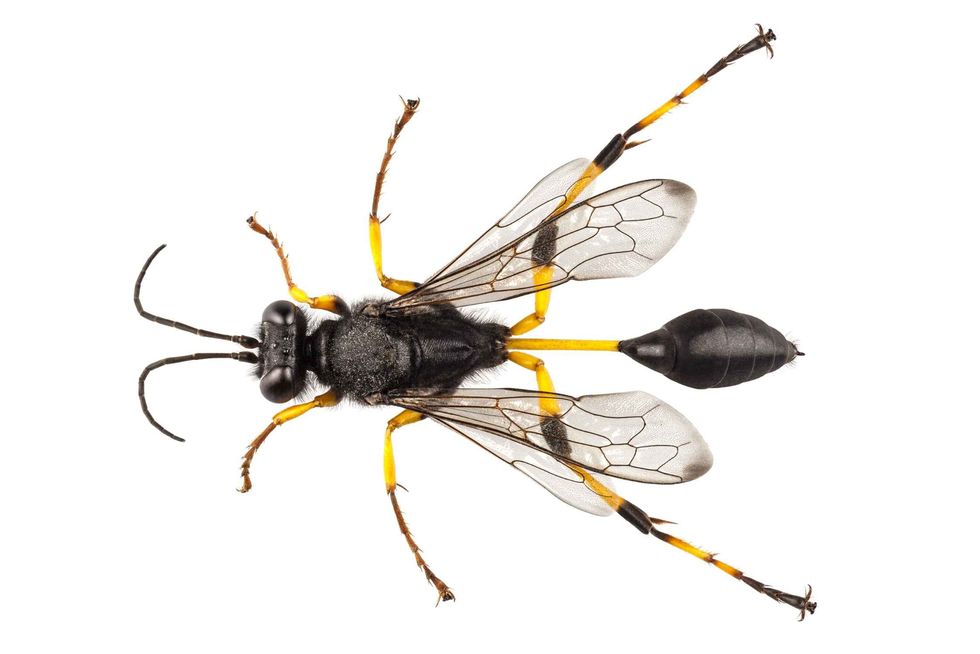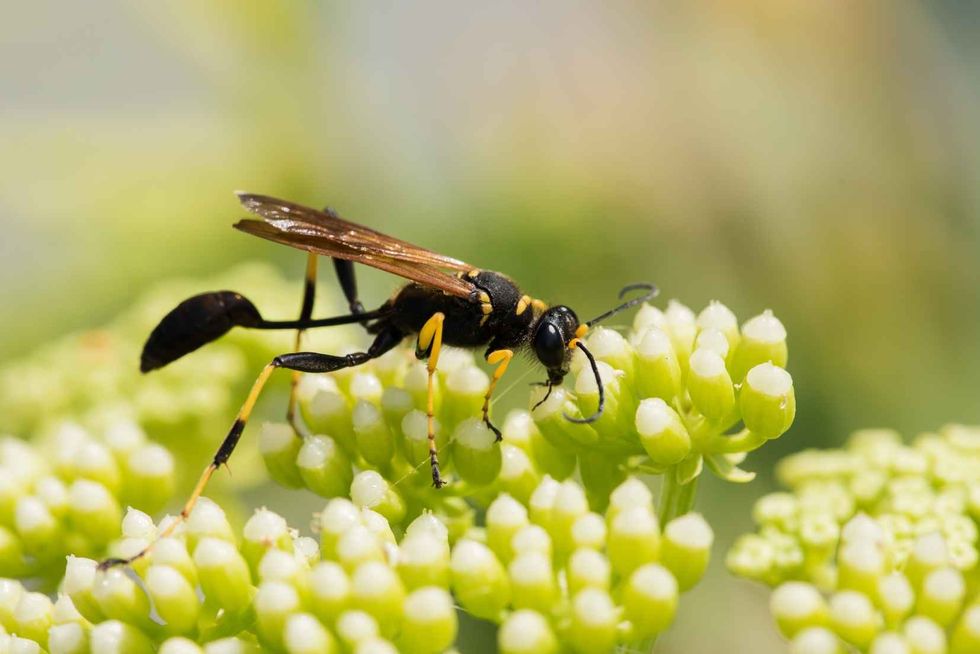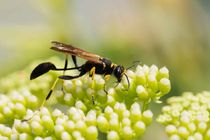Different Types Of Wasps: Guide To Identify All Species

Wasps are neither ants nor bees and are often confused with these insect species.
A wasp is a small insect that is known to be narrow-shaped at its waist. A few of the wasp species are called stinging wasps when they turn aggressive.
The wasps such as yellowjackets and hornets belong to the family of Vespidae and are classified among the highest levels of organization and sociality. However, the majority of wasp species are solitary by nature and breed on their own.
A few wasps are known to live in groups in a nest with their queen. The wasps that spend most of their time in solitude are best recalled for their work as parasites on other pest insects.
Thus, wasps are also a biological way to control crop pest insects.
The first fossil wasps are dated back to the Jurassic period, with a few of their families living in the Cretaceous period. There are also different types of wasps (parasitic) that help in the control of pests.
The largest social wasps are the European hornet from the family of Vespa carbro and the Asian giant hornet from the family of Vespa mandarinia, while the largest solitary wasps are the tarantula hawks from the family of Pompilidae. The smallest solitary wasps are the chalcid wasps.
Wasps belong to the order of Hymenoptera. In the summer or autumn season, few of the wasp species are called pests because they build up their large colonies and nest either on the rooftops or corners of the buildings, making it difficult for people to wander around.
The sting of these wasps is painful and can cause trouble for a period of 14-15 days.
In a few cases, it can also be life-threatening. If you spot social wasps around you, then you must immediately work on pest control to avoid these stinging insects.
If you liked this article about different types of wasps, then you should read some interesting and fun fact articles about different types of tigers and different types of turtles.
Facts About Wasps
Wasps are small flying insects, either social wasps with a narrow waist and sting or solitary wasps with similar narrow waists and stings. Social wasps are the pests, whereas, solitary wasps are biological ways to control pests.
Wasps belong to the phylum of Arthropoda, class of Insecta, and superorder of Hymenopterida. Wasps belong to the order of Hymenoptera. The social wasps belong to the family of Vespidae.
Social wasps are known to work in colonies and groups. They are always led by a queen and the other female workers work with cooperation. Most of the social wasp species are known to survive for one year and die with the arrival of winter.
They are mostly seen in the spring and summer seasons. The queen is known to hibernate during the winter season.
The paper wasp's nest can vary in the number of insect bodies in colonies. A few solitary wasp species are also included in social wasp species due to their behavior, such as potter wasps and pollen wasps, etc.
Scoliid wasps are types of wasps found in a wide range of habitats, from New England to Florida. The solitary wasps, also called hunting wasps, do not have a single family but rather have many families within them.
The female wasps' mud nest or paper nest does not last for long because once the female lays eggs, the larvae hatch and fly away on their own. The larvae are taken care of by the female species and are fed with spiders and small insects.
There is no such division of workers and no such complex behavior in the solitary wasps that are observed. Comparatively, the sting of wasps is painful and can last for 14-15 days, causing problems.
It can potentially be life-threatening in some situations. If you see social wasps around you, you must take prompt pest control measures to avoid being stung.
Adult solitary wasps are known to spend most of their time building their small nests on porch ceilings and searching for food. They are even thread-waisted and have very few or no hairs on their bodies.
The best examples of wasp nests are spider wasps, who build nests in hard or rotten wood, while potter wasps build nests out of mud. Yellowjackets, hornets, and paper wasps' nests are a rudimentary types of nests and have multiple layers.
How are wasps different from hornets?
All hornets are wasps, but not all wasps can be hornets. They can be differentiated on the basis of their size, color, diet, and nests.
Multiple times, hornets and wasps are confused for each other. Both species are small insects and are varied scientifically on the basis of the families and orders they belong to. The true hornet species in North America is the European hornet. Hornets are mostly bald-faced, while wasps have yellowjackets and paper wasps.
Hornets are members of the Vespidae family and typically build their nests in trees or underground in cavities or hollow trees. European hornets are known to sting repeatedly. The European hornet is also called the giant hornet.
The face of the European hornets is pale. The male hornets are docile and do not sting.
Similar to social wasps, they chew paper pulp to make paper nests. Hornet bodies have black and white or yellow and black stripes or bands. They have a soft body and texture.
The waist of the hornet is similar to that of a wasp. If a hornet feels any threat around themselves, they can turn aggressive and may even sting you, which can be very painful on that particular body part with redness and swelling.
Hornets can grow up to 2 in (5.5 cm) in length, whereas most wasps are smaller than hornets. The nests of hornets are aerial, rounder, and made from paper.
They mostly build up colonies of 100-700 in their nests, whereas, a wasp nest can be above ground or under the ground, depending upon the species. The yellowjackets or wasp nests are made of both mud and paper. The wasp comes in a variety of colors, i.e., blue, black, brown, with yellow markings.
Adult solitary wasps are reported to spend most of their time looking for food and establishing modest nests on porch ceilings. They're even thread-waisted, and their bodies have no hairs.
However, yellow and black or yellow and brown-marked wasps are greater in number. A hornet feeds on other insects, such as small spiders and larvae.
The hornet is a rare scavenger of protein and sweets. A wasp is more likely to be a scavenger of protein and sweets. A hornet is a very aggressive creature if its nest is disturbed, while a yellowjacket will sting you, and a paper wasp is not likely to sting you.

List Of Different Wasps Types
There are two different types of wasps: social wasps and solitary wasps. Social wasps include hornets and yellowjackets, which are one of the more aggressive types of wasp species, while solitary wasps live their lives in solitude and there are four main types of this category.
The four main types of wasp species are the cuckoo wasp from the family of Chrysididae, the tiphiid wasp from the family of Tiphiidae, the scoliid wasp from the family of Scoliidae, and the velvet wasp from the family of Mutillidae. Solitary wasps generally do not engage in building colonies and are more parasitic by nature.
Social wasps are more into building nests and building up large colonies.
They are even more aggressive wasp species that often sting the bodies of individuals. A few solitary wasp species are also included in social wasp species such as potter wasps, etc.
Yellowjackets, or yellow jackets, are one of the most aggressive wasp species found in North America. Yellowjackets have black and yellow markings on their body with two big black eyes on their head. Yellowjackets are often confused with other wasp species, parricularly paper wasps and hornets.
The queen of yellowjackets is 0.75 in (1.9 cm) in length. Yellowjackets look similar to honey bees.
The aerial nests of yellowjackets exist for only one season, mostly drying out in the winter season. In exceptional cases, if the nests of yellowjackets exist for more than one year, then multiple times the eggs of the queen can be seen. The stinging insect, a German yellowjacket, was first recovered from Ohio in 1975.
The northern paper wasp belongs to the wasp family of Vespidae and is brown, yellow, and black in color. North American paper wasps are widely distributed in North America and form a complex society in their aerial nests.
The northern paper wasp has six legs, similar to the legs count of a yellowjacket species. The northern paper wasp has a thin thread-like waist, while its abdomen points towards the end. The wings near the thorax part of the bodies are brown and black in color.
Apart from northern paper wasps, there are different types of paper wasps such as European paper wasps, golden paper wasps, Asian paper wasps, yellow paper wasps, and apache paper wasps, etc. Mud daubers, also called mud wasps or dirt daubers, are solitary types of wasp species.
The mud dauber is black and yellow in color. Paper wasps, hornets, yellowjackets are some of the most common and worst types of wasps.
Most mud dauber species are black in color. The legs of these wasp-like insects are more yellow in color.
The mud dauber is known to build their nests with mud in the shape of a cigar and one cell. Mud dauber is not that aggressive in comparison to other wasps.
The European hornet is the only real hornet species in North America. Hornets are generally bald-faced, although yellowjackets and paper wasps are found among wasps. Hornets belong to the Vespidae family and make their nests in cavities or hollow trunks in trees or underground.
The cicada killer, or cicada hawk, is a solitary wasp with a black abdomen and thorax. Cicada hawks have yellow stripes on their bodies and have brown-colored wings, unlike blue-winged wasps.
Cicadas mostly build their nests underground. The female cicada generally avoids the human presence but might deploy their stingers to sting repeatedly if they sense danger. The males do not have stings.
Cicada larvae feed on insects, while adults feed on the sap of trees near their woodlands. In North America, they are called eastern cicada killers. Some other types of wasps are spider wasp, blue-winged wasp, true wasp, and Asian giant hornet.
How to identify a wasp?
The different types of wasp identification can really be a hard task because you might even be scared of wasp stings, especially from the stings of a yellowjacket, European paper wasp, and hornet.
You all must be well acquainted with honey bees because of their honey and their stings, but wasps are identified by the type of wasp nest, size, color, and sting. For example, the blue-winged wasp can be recognized by its blue wings, black abdomen, and thorax.
Both the blue-winged wasp and the European paper wasp sting, but they are less aggressive and only found in North America.
Mud daubers have a thread-like waist with a small abdomen of brown-black color. The legs of mud daubers are big and of yellow color. The wings of mud daubers are yellow in color.
Mud daubers are metallic black and blue in color. Mud daubers are ideally considered as pest control for the Vespa family, yellowjackets, and hornets. Mud daubers are predators of brown and black widow spiders.
Spider wasps are shiny, dark blue-brown in color, with yellow bands or rings on their bodies. The spider wasp is prominently black and can also build its nests in wall voids, like the yellowjacket wasp. Both species feed on flower nectar and small insect species.
The nest of a spider wasp can also be seen in tree hollows. Yellowjackets and honey bees are often misidentified due to their similar colors. The Vespa family species' yellowjacket is hairless and bright and shiny with yellow-black markings on its body.
If you find an aerial nest of Vespa family stinging insects, hornets, or yellowjackets, then you might now easily identify them if they are bright yellow and black in color without hairs on their bodies. If you ever spot any red-colored flying insect, then you must alert yourself as this could be a red paper wasp.
These Vespa family members' stings are equally painful as the tarantula hawk sting.
Tarantula hawks nest underground and are solitary wasp species. They can be seen in trees and are specifically black in color with yellow wings and markings on their body.
Here at Kidadl, we have carefully created lots of interesting family-friendly facts for everyone to enjoy! If you liked our suggestions for different types of wasps, then why not take a look at different types of moths, or red paper wasp interesting facts for kids?
We Want Your Photos!
More for You
Bachelor of Arts specializing in English, Bachelor of Education specializing in Secondary Education and Teaching, Master of Arts specializing in English

Anamika BalouriaBachelor of Arts specializing in English, Bachelor of Education specializing in Secondary Education and Teaching, Master of Arts specializing in English
Bachelor of Commerce specializing in Marketing and HR

Pradhanya RaoBachelor of Commerce specializing in Marketing and HR
With a Bachelor’s degree in Commerce from Christ University, Bangalore, Pradhanya's passion for the English language and literature led her to explore the field of content writing, where she has gained extensive experience in writing, reviewing, editing, and fact-checking. She has also earned certifications in Google Ads Search, Google Ads Display, and Social Media Marketing, showcasing her proficiency in digital marketing.
Disclaimer
1) Kidadl is independent and to make our service free to you the reader we are supported by advertising. We hope you love our recommendations for products and services! What we suggest is selected independently by the Kidadl team. If you purchase using the Buy Now button we may earn a small commission. This does not influence our choices. Prices are correct and items are available at the time the article was published but we cannot guarantee that on the time of reading. Please note that Kidadl is a participant in the Amazon Services LLC Associates Program, an affiliate advertising program designed to provide a means for sites to earn advertising fees by advertising and linking to Amazon. We also link to other websites, but are not responsible for their content.
2) At Kidadl, we strive to recommend the very best activities and events. We will always aim to give you accurate information at the date of publication - however, information does change, so it’s important you do your own research, double-check and make the decision that is right for your family. We recognise that not all activities and ideas are appropriate for all children and families or in all circumstances. Our recommended activities are based on age but these are a guide. We recommend that these ideas are used as inspiration, that ideas are undertaken with appropriate adult supervision, and that each adult uses their own discretion and knowledge of their children to consider the safety and suitability. Kidadl cannot accept liability for the execution of these ideas, and parental supervision is advised at all times, as safety is paramount. Anyone using the information provided by Kidadl does so at their own risk and we can not accept liability if things go wrong.
3) Because we are an educational resource, we have quotes and facts about a range of historical and modern figures. We do not endorse the actions of or rhetoric of all the people included in these collections, but we think they are important for growing minds to learn about under the guidance of parents or guardians.







